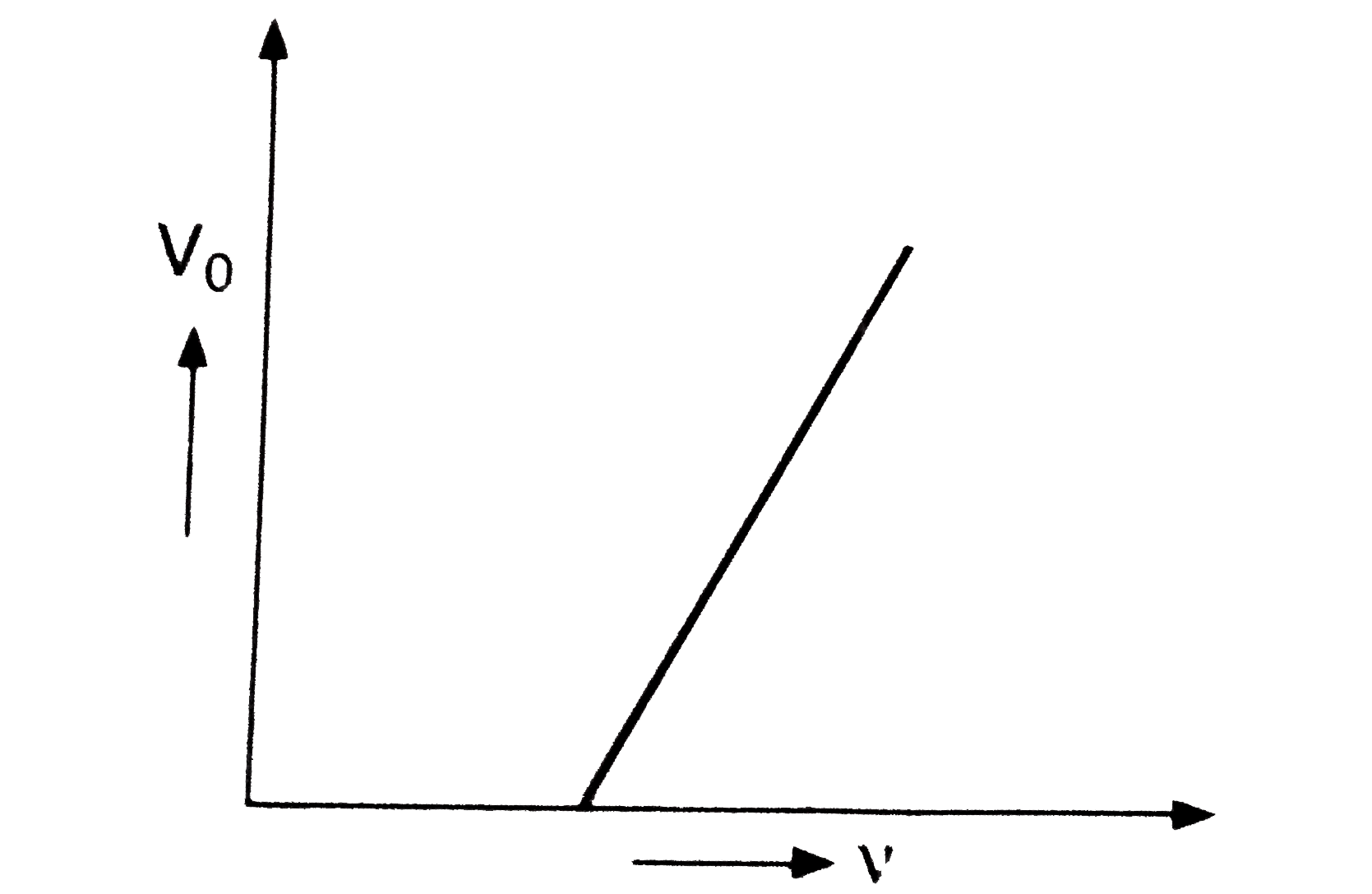A mercury lamp is a convenient source for studying frequency dependence of photoelectric emission, since it gives a number of spectral lines ranging from the UV to the end of the red visible spectrum. In our experiment with rubidium photocell, the following lines from a mercury source were used: λ1=3650A∘,λ2=4047A∘,λ3=4358A∘,λ4=5461A∘,λ5=6907A∘ The stopping voltages, respectively were measured to be:
V01=1.28V,V02=0.95V,V03=0.74V,V04=0.16V,V05=0V.
(a) Determine the value of Planck's constant h.
(b) Estimate the threshold frequency and work function for the material.
Using v=c/λ , let us first calculate corresponding frequencies.
λv=c/λV03,650Å8.22×1014Hz1.28V4,047Å7.41×1014Hz0.95V4,358Å7.41×1014Hz0.74V5,461Å5.49×1014Hz0.16V6,907Å4.34×1014Hz0.0V
We know that eV0=hv−W0
Or V0=hve=W0e
(a) The graph between vandv0 is a straight line as shown below.

The slope of the plot is h/e and its Intercept on the V- axis is threshold frequency (v0) . The first four points lie nearly on a straight line which intercepts the v-axis at v0=5.0×1014Hz . The fifth point corresponds to v<v0 no photoelectric emission occurs, so no stopping voltage is required to stop the current .
Slope of teh plot is found to be
m=he=V01−V04v1−v4=(1.28−0.16)V(8.22−5.49)×1014Hz
⇒h=1.12×1.6×10−192.73×1014=6.56×10−34Js
(b) From the graph, it us clear that the threshold frequency for the given material is
v0=5.0×1014Hz.
Thus the work function is given be
W0=(6.574×10−34)×(5.0×1014)
=32.87×10−20J
Or W0=32.87×10−201.6×10−19=2.05eV
Topper's Solved these Questions
- DUAL NATURE OF RADIATION AND MATTER BOOK - MODERN PUBLICATIONCHAPTER - DUAL NATURE OF RADIATION AND MATTER EXERCISE - NCERT FILE (NCERT - Exemplar Problems - Objective Questions (Multiple Choice Questions (Type - I)))
8 Videos
- DUAL NATURE OF RADIATION AND MATTER BOOK - MODERN PUBLICATIONCHAPTER - DUAL NATURE OF RADIATION AND MATTER EXERCISE - NCERT FILE (NCERT - Exemplar Problems - Objective Questions (Multiple Choice Questions (Type - II)))
5 Videos
- DUAL NATURE OF RADIATION AND MATTER BOOK - MODERN PUBLICATIONCHAPTER - DUAL NATURE OF RADIATION AND MATTER EXERCISE - NCERT FILE (Textbook Exercises)
19 Videos
- CURRENT ELECTRICITYBOOK - MODERN PUBLICATIONCHAPTER - CURRENT ELECTRICITYEXERCISE - Chapter Practice Test
15 Videos
- ELECTRIC CHARGES AND FIELDS BOOK - MODERN PUBLICATIONCHAPTER - ELECTRIC CHARGES AND FIELDS EXERCISE - Chapter Practice Test
15 Videos
Similar Questions
A mercury lamp is a convenient source for studying frequency dependence of photoelectric emission, since it gives a number of spectral lines ranging from the UV to the red and end of the visible spectrum. In our experiment with rubidium photocell, the following lines from a mercury source were used:
λ1=3650Å,λ2=4047Å,λ3=4358Å,λ4=5461Å,λ5=6907Å
The stopping voltages, respectively, were measured to be:
V01=1.28V,V02=0.95V,V03=0.74V,V04=0.16V,V05=0V
Determine the value of Planck's constant h, the threshold frequency and work function for the material.
View SolutionWrite Einstein’s photoelectric equation. Define the threshold frequency v0 and stopping potential V0.
View Solution
Knowledge Check
A photon of frequency v causes photo electric emission from a surface with threshold frequency v0. The de-Broglies wavelength (λ) of the photo electron emitted is given by:
AΔn=h2mλBΔn=hλC[1v0−1v]=mc2hDλ=√h2mΔVIf λv,λmandλx represent wavlength of visible light, microwaves and X - rays respectively, then
Aλm<λx<λvBλv<λm<λxCλx<λv<λmDλm<λv<λxif λv',λx and λm represent the wavelengths of visible light X-rays and microwaves respectively then:
Aλm>λx>λvBλk>λm>λxCλm>λv>λxDλy>λx>λm
Derive the equations v=nλ , where n and λ are frequency and wavelength .
View SolutionIn photoelectric effect the slope of straight line graph between stopping potential (V0) and freqency of incident light (v) gives:

View SolutionThe stopping potential are V1 and V2. Calculate the (V1−V2), if the λ1 and λ2 are wavelength of incident lights, respectively.
View SolutionIf V1 and V2 are veloctities of light in two different media, then the ratio of wavelength of light in the same media λ1λ2=
View SolutionIf λv,λx and λm represents the wavelength of visible light X-ray and microwave respectively then :
View Solution
